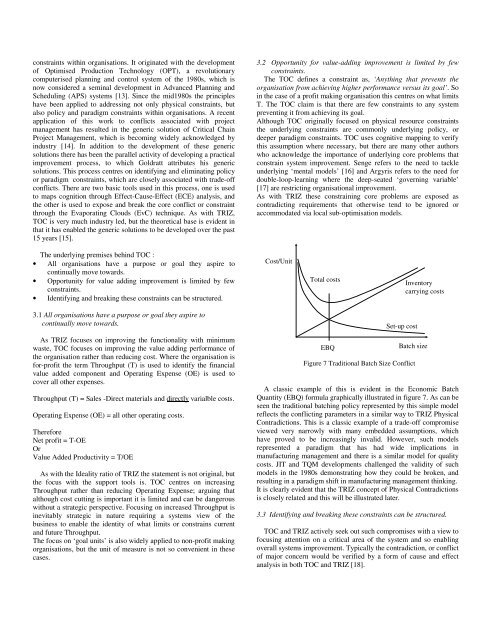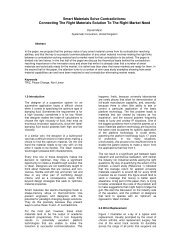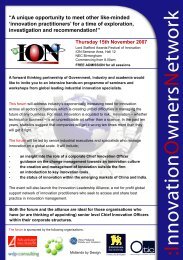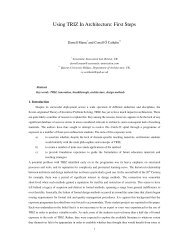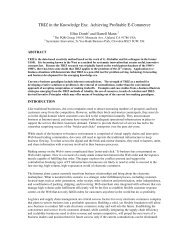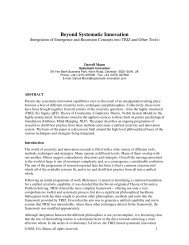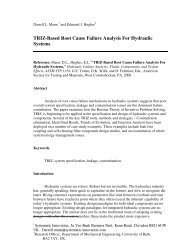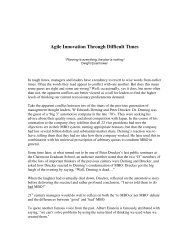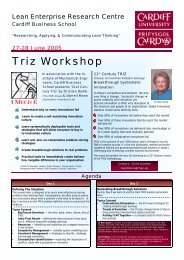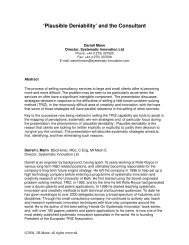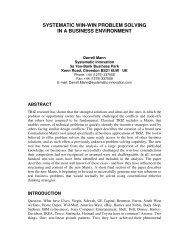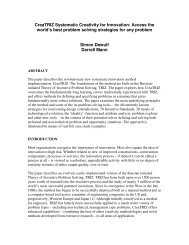From trade-offs to innovation - the underlying principles of TRIZ and ...
From trade-offs to innovation - the underlying principles of TRIZ and ...
From trade-offs to innovation - the underlying principles of TRIZ and ...
Create successful ePaper yourself
Turn your PDF publications into a flip-book with our unique Google optimized e-Paper software.
constraints within organisations. It originated with <strong>the</strong> development<br />
<strong>of</strong> Optimised Production Technology (OPT), a revolutionary<br />
computerised planning <strong>and</strong> control system <strong>of</strong> <strong>the</strong> 1980s, which is<br />
now considered a seminal development in Advanced Planning <strong>and</strong><br />
Scheduling (APS) systems [13]. Since <strong>the</strong> mid1980s <strong>the</strong> <strong>principles</strong><br />
have been applied <strong>to</strong> addressing not only physical constraints, but<br />
also policy <strong>and</strong> paradigm constraints within organisations. A recent<br />
application <strong>of</strong> this work <strong>to</strong> conflicts associated with project<br />
management has resulted in <strong>the</strong> generic solution <strong>of</strong> Critical Chain<br />
Project Management, which is becoming widely acknowledged by<br />
industry [14]. In addition <strong>to</strong> <strong>the</strong> development <strong>of</strong> <strong>the</strong>se generic<br />
solutions <strong>the</strong>re has been <strong>the</strong> parallel activity <strong>of</strong> developing a practical<br />
improvement process, <strong>to</strong> which Goldratt attributes his generic<br />
solutions. This process centres on identifying <strong>and</strong> eliminating policy<br />
or paradigm constraints, which are closely associated with <strong>trade</strong>-<strong>of</strong>f<br />
conflicts. There are two basic <strong>to</strong>ols used in this process, one is used<br />
<strong>to</strong> maps cognition through Effect-Cause-Effect (ECE) analysis, <strong>and</strong><br />
<strong>the</strong> o<strong>the</strong>r is used <strong>to</strong> expose <strong>and</strong> break <strong>the</strong> core conflict or constraint<br />
through <strong>the</strong> Evaporating Clouds (EvC) technique. As with <strong>TRIZ</strong>,<br />
TOC is very much industry led, but <strong>the</strong> <strong>the</strong>oretical base is evident in<br />
that it has enabled <strong>the</strong> generic solutions <strong>to</strong> be developed over <strong>the</strong> past<br />
15 years [15].<br />
3.2 Opportunity for value-adding improvement is limited by few<br />
constraints.<br />
The TOC defines a constraint as, ‘Anything that prevents <strong>the</strong><br />
organisation from achieving higher performance versus its goal’. So<br />
in <strong>the</strong> case <strong>of</strong> a pr<strong>of</strong>it making organisation this centres on what limits<br />
T. The TOC claim is that <strong>the</strong>re are few constraints <strong>to</strong> any system<br />
preventing it from achieving its goal.<br />
Although TOC originally focused on physical resource constraints<br />
<strong>the</strong> <strong>underlying</strong> constraints are commonly <strong>underlying</strong> policy, or<br />
deeper paradigm constraints. TOC uses cognitive mapping <strong>to</strong> verify<br />
this assumption where necessary, but <strong>the</strong>re are many o<strong>the</strong>r authors<br />
who acknowledge <strong>the</strong> importance <strong>of</strong> <strong>underlying</strong> core problems that<br />
constrain system improvement. Senge refers <strong>to</strong> <strong>the</strong> need <strong>to</strong> tackle<br />
<strong>underlying</strong> ‘mental models’ [16] <strong>and</strong> Argyris refers <strong>to</strong> <strong>the</strong> need for<br />
double-loop-learning where <strong>the</strong> deep-seated ‘governing variable’<br />
[17] are restricting organisational improvement.<br />
As with <strong>TRIZ</strong> <strong>the</strong>se constraining core problems are exposed as<br />
contradicting requirements that o<strong>the</strong>rwise tend <strong>to</strong> be ignored or<br />
accommodated via local sub-optimisation models.<br />
The <strong>underlying</strong> premises behind TOC :<br />
• All organisations have a purpose or goal <strong>the</strong>y aspire <strong>to</strong><br />
continually move <strong>to</strong>wards.<br />
• Opportunity for value adding improvement is limited by few<br />
constraints.<br />
• Identifying <strong>and</strong> breaking <strong>the</strong>se constraints can be structured.<br />
Cost/Unit<br />
Total costs<br />
Inven<strong>to</strong>ry<br />
carrying costs<br />
3.1 All organisations have a purpose or goal <strong>the</strong>y aspire <strong>to</strong><br />
continually move <strong>to</strong>wards.<br />
As <strong>TRIZ</strong> focuses on improving <strong>the</strong> functionality with minimum<br />
waste, TOC focuses on improving <strong>the</strong> value adding performance <strong>of</strong><br />
<strong>the</strong> organisation ra<strong>the</strong>r than reducing cost. Where <strong>the</strong> organisation is<br />
for-pr<strong>of</strong>it <strong>the</strong> term Throughput (T) is used <strong>to</strong> identify <strong>the</strong> financial<br />
value added component <strong>and</strong> Operating Expense (OE) is used <strong>to</strong><br />
cover all o<strong>the</strong>r expenses.<br />
Throughput (T) = Sales -Direct materials <strong>and</strong> directly varialble costs.<br />
Operating Expense (OE) = all o<strong>the</strong>r operating costs.<br />
Therefore<br />
Net pr<strong>of</strong>it = T-OE<br />
Or<br />
Value Added Productivity = T/OE<br />
As with <strong>the</strong> Ideality ratio <strong>of</strong> <strong>TRIZ</strong> <strong>the</strong> statement is not original, but<br />
<strong>the</strong> focus with <strong>the</strong> support <strong>to</strong>ols is. TOC centres on increasing<br />
Throughput ra<strong>the</strong>r than reducing Operating Expense; arguing that<br />
although cost cutting is important it is limited <strong>and</strong> can be dangerous<br />
without a strategic perspective. Focusing on increased Throughput is<br />
inevitably strategic in nature requiring a systems view <strong>of</strong> <strong>the</strong><br />
business <strong>to</strong> enable <strong>the</strong> identity <strong>of</strong> what limits or constrains current<br />
<strong>and</strong> future Throughput.<br />
The focus on ‘goal units’ is also widely applied <strong>to</strong> non-pr<strong>of</strong>it making<br />
organisations, but <strong>the</strong> unit <strong>of</strong> measure is not so convenient in <strong>the</strong>se<br />
cases.<br />
EBQ<br />
Set-up cost<br />
Batch size<br />
Figure 7 Traditional Batch Size Conflict<br />
A classic example <strong>of</strong> this is evident in <strong>the</strong> Economic Batch<br />
Quantity (EBQ) formula graphically illustrated in figure 7. As can be<br />
seen <strong>the</strong> traditional batching policy represented by this simple model<br />
reflects <strong>the</strong> conflicting parameters in a similar way <strong>to</strong> <strong>TRIZ</strong> Physical<br />
Contradictions. This is a classic example <strong>of</strong> a <strong>trade</strong>-<strong>of</strong>f compromise<br />
viewed very narrowly with many embedded assumptions, which<br />
have proved <strong>to</strong> be increasingly invalid. However, such models<br />
represented a paradigm that has had wide implications in<br />
manufacturing management <strong>and</strong> <strong>the</strong>re is a similar model for quality<br />
costs. JIT <strong>and</strong> TQM developments challenged <strong>the</strong> validity <strong>of</strong> such<br />
models in <strong>the</strong> 1980s demonstrating how <strong>the</strong>y could be broken, <strong>and</strong><br />
resulting in a paradigm shift in manufacturing management thinking.<br />
It is clearly evident that <strong>the</strong> <strong>TRIZ</strong> concept <strong>of</strong> Physical Contradictions<br />
is closely related <strong>and</strong> this will be illustrated later.<br />
3.3 Identifying <strong>and</strong> breaking <strong>the</strong>se constraints can be structured.<br />
TOC <strong>and</strong> <strong>TRIZ</strong> actively seek out such compromises with a view <strong>to</strong><br />
focusing attention on a critical area <strong>of</strong> <strong>the</strong> system <strong>and</strong> so enabling<br />
overall systems improvement. Typically <strong>the</strong> contradiction, or conflict<br />
<strong>of</strong> major concern would be verified by a form <strong>of</strong> cause <strong>and</strong> effect<br />
analysis in both TOC <strong>and</strong> <strong>TRIZ</strong> [18].


